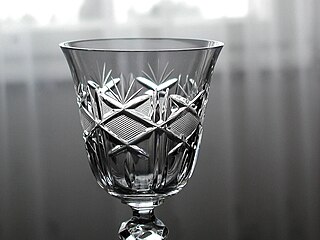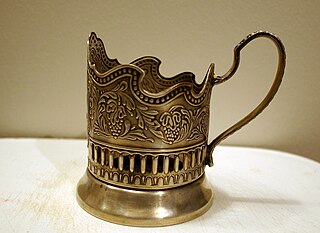
Glass is a non-crystalline, often transparent amorphous solid, that has widespread practical, technological, and decorative use in, for example, window panes, tableware, and optics. Glass is most often formed by rapid cooling (quenching) of the molten form; some glasses such as volcanic glass are naturally occurring. The most familiar, and historically the oldest, types of manufactured glass are "silicate glasses" based on the chemical compound silica, the primary constituent of sand. Soda-lime glass, containing around 70% silica, accounts for around 90% of manufactured glass. The term glass, in popular usage, is often used to refer only to this type of material, although silica-free glasses often have desirable properties for applications in modern communications technology. Some objects, such as drinking glasses and eyeglasses, are so commonly made of silicate-based glass that they are simply called by the name of the material.

A shot glass glass originally designed to hold or measure spirits or liquor, which is either imbibed straight from the glass or poured into a cocktail. An alcoholic beverage served in a shot glass and typically consumed quickly, in one gulp, may also be known as a "shooter".

Lead glass, commonly called crystal, is a variety of glass in which lead replaces the calcium content of a typical potash glass. Lead glass contains typically 18–40% lead(II) oxide (PbO), while modern lead crystal, historically also known as flint glass due to the original silica source, contains a minimum of 24% PbO. Lead glass is often desirable for a variety of uses due to its clarity.

A cocktail glass is a stemmed glass with an inverted cone bowl, mainly used to serve straight-up cocktails. The term cocktail glass is often used interchangeably with martini glass, despite their differing slightly.

Grappa is an alcoholic beverage: a fragrant, grape-based pomace brandy of Italian origin that contains 35 to 60 percent alcohol by volume. Grappa is traditionally produced in Northern Italy and is also widely consumed in places like Argentina, Bulgaria and Uruguay.

Stemware is drinkware that stands on stems above a base. It is usually made from glass, but may be made from ceramics or metals. The stem allows the drinker to hold the glass without affecting the temperature of the drink.

A prunt is a small blob of glass fused to another piece of glass. Prunts are applied primarily as decoration, but also help provide a firm grip in the absence of a handle. Prunts may be impressed into decorative shapes, such as raspberries, blackberries, or lion's heads.

Syllabub is an English sweet frothy drink which was popular from the 16th to 19th centuries. Syllabub also refers to a dessert based on the drink, which is still eaten. The drink was made of milk or cream, curdled by the addition of wine, cider, or other acid, and often sweetened and flavoured. The dessert is typically made of whipped cream, wine or sherry, sugar and lemon juice.

A wine glass is a type of glass that is used to drink and taste wine. Most wine glasses are stemware, that is they are goblets composed of three parts: the bowl, stem, and foot.

Beer glassware comprise vessels made of glass, designed or commonly used for serving and drinking beer. Styles of glassware vary in accord with national or regional traditions; legal or customary requirements regarding serving measures and fill lines; such practicalities as breakage avoidance in washing, stacking or storage; commercial promotion by breweries; artistic or cultural expression in folk art or as novelty items or usage in drinking games; or to complement, to enhance, or to otherwise affect a particular type of beer's temperature, appearance and aroma, as in the case of its head. Drinking vessels intended for beer are made from a variety of materials other than glass, including pottery, pewter, and wood.
Absinthiana are the accoutrements surrounding the drink absinthe and its preparation. Originally, absinthe was served in standard stemmed wine or water glasses and water was added from a simple carafe. But as its popularity grew so did the variety of implements used, such as specialty glasses and complex brouilleurs. In the period since absinthe was made illegal in the US, antique dealers have seen dramatic increases in the prices of these artifacts there. Some absinthe spoons can fetch thousands of dollars. Many 19th century companies used the elaborate barware to advertise their brands. Today, many contemporary distilleries are also producing decorative branded barware for the same purpose.

The podstakannik, or tea glass holder, is a holder with a handle, most commonly made of metal that holds a drinking glass (stakan). Their primary purpose is to be able to hold a very hot glass of tea, which is usually consumed right after it is brewed. The stability of the glass on the table is also significantly improved. It is a traditional way of serving and drinking tea in Russia, Ukraine, Belarus, and other post-Soviet states.

A Champagne glass is a form of stemware designed specifically to enhance the drinking of champagne. The two most common forms are the flute and coupe. In each the stem allows the drinker to hold the glass without affecting the temperature of the drink, making them readily adaptable to consuming other sparkling wines and certain beers. Champagne can also be drunk from a normal wine glass, which allows better appreciation of the flavor, at the expense of accentuating the bubbles less; this has become increasingly popular since the 2010s.

Römers or Roemers and other variations, were large drinking-glasses studded with prunts to ensure a safe grip, popular mainly in the Rhineland and the Netherlands from the 15th through the 17th century. They lacked the flared bowl of the Berkemeyer and had much thinner walls. The hollow base was built up by coiling strands of molten glass around a conical core. Römers were quite distinct from the Berkemeyers, but both types evolved from the German "cabbage stalk" glasses which were cylindrical with prunts. Römers are usually green in colour and with Berkemeyers were sometimes engraved with images and inscriptions.

An alcoholic drink is a drink that contains the recreational drug ethanol, a type of alcohol produced by fermentation of grains, fruits, or other sources of sugar. The consumption of alcohol plays an important social role in many cultures. Most countries have laws regulating the production, sale, and consumption of alcoholic beverages. Some countries ban such activities entirely, but alcoholic drinks are legal in most parts of the world. The global alcoholic drink industry exceeded $1 trillion in 2018.

Pulque, or octli, is an alcoholic beverage made from the fermented sap of the maguey (agave) plant. It is traditional to central Mexico, where it has been produced for millennia. It has the color of milk, somewhat viscous consistency and a sour yeast-like taste.
A glossary of terms used in glass art

A faceted glass or granyonyi stakan is a type of drinkware made from especially hard and thick glass and having a faceted form. It is a very widespread form of drinking glass in Russia and the former Soviet Union.

Gold glass or gold sandwich glass is a luxury form of glass where a decorative design in gold leaf is fused between two layers of glass. First found in Hellenistic Greece, it is especially characteristic of the Roman glass of the Late Empire in the 3rd and 4th century AD, where the gold decorated roundels of cups and other vessels were often cut out of the piece they had originally decorated and cemented to the walls of the catacombs of Rome as grave markers for the small recesses where bodies were buried. About 500 pieces of gold glass used in this way have been recovered. Complete vessels are far rarer. Many show religious imagery from Christianity, traditional Greco-Roman religion and its various cultic developments, and in a few examples Judaism. Others show portraits of their owners, and the finest are "among the most vivid portraits to survive from Early Christian times. They stare out at us with an extraordinary stern and melancholy intensity". From the 1st century AD the technique was also used for the gold colour in mosaics.



















